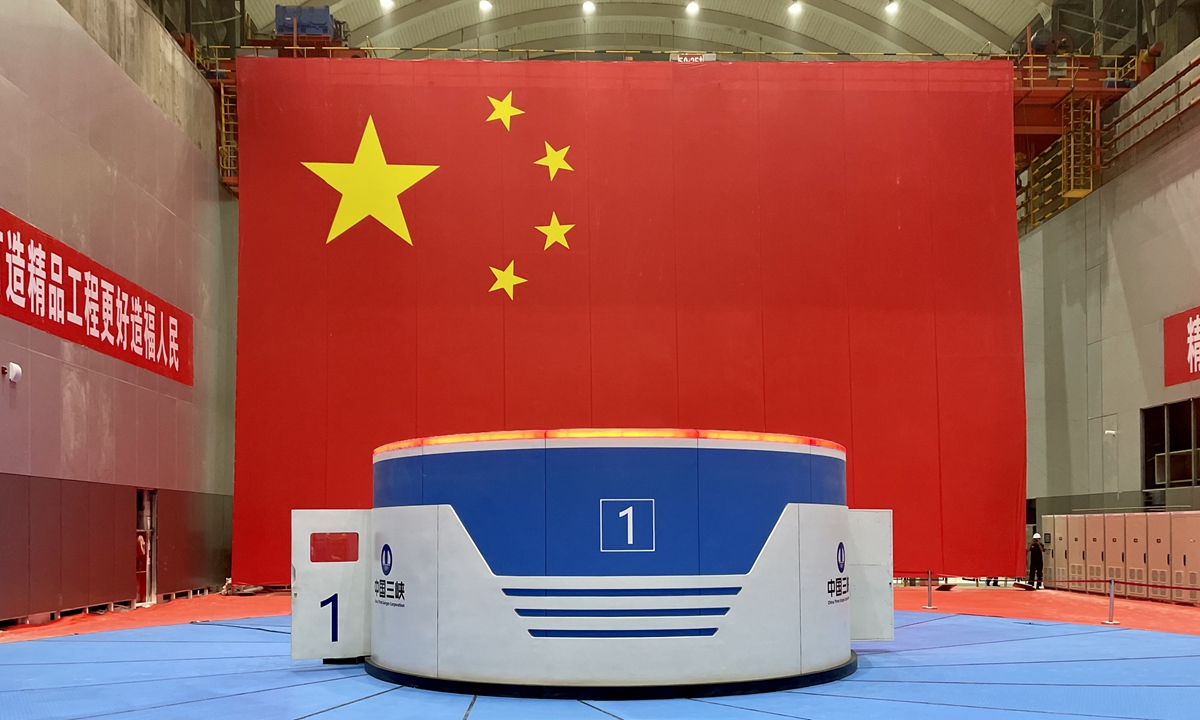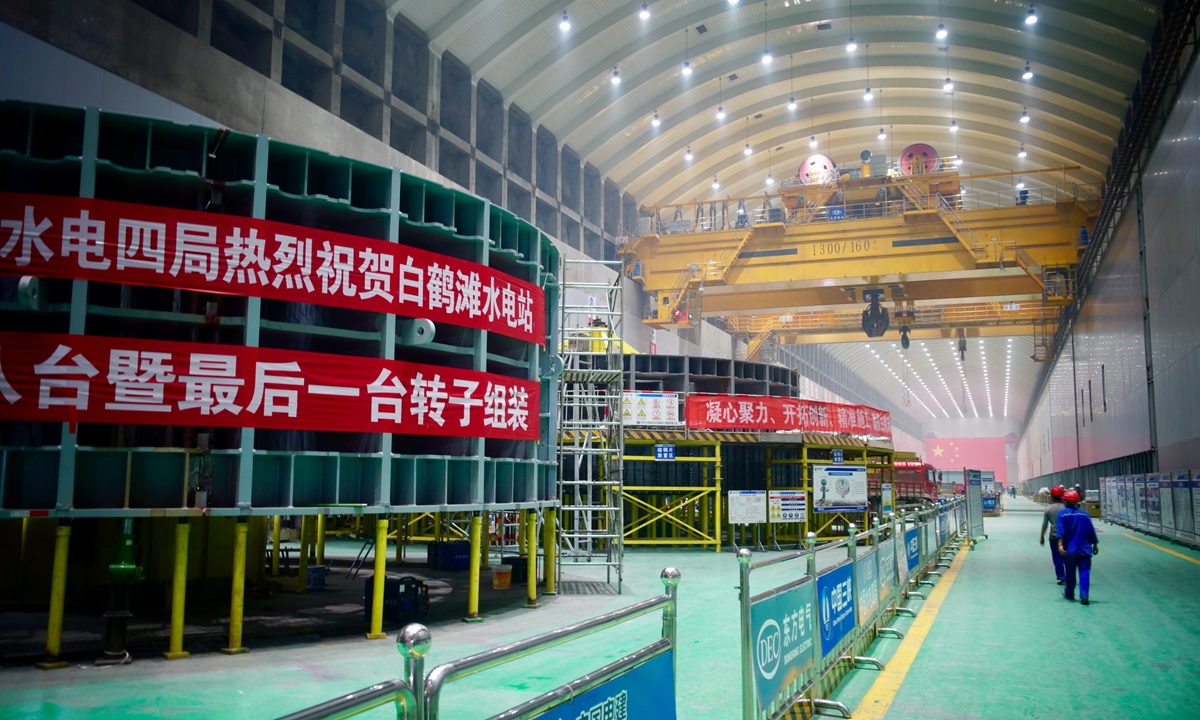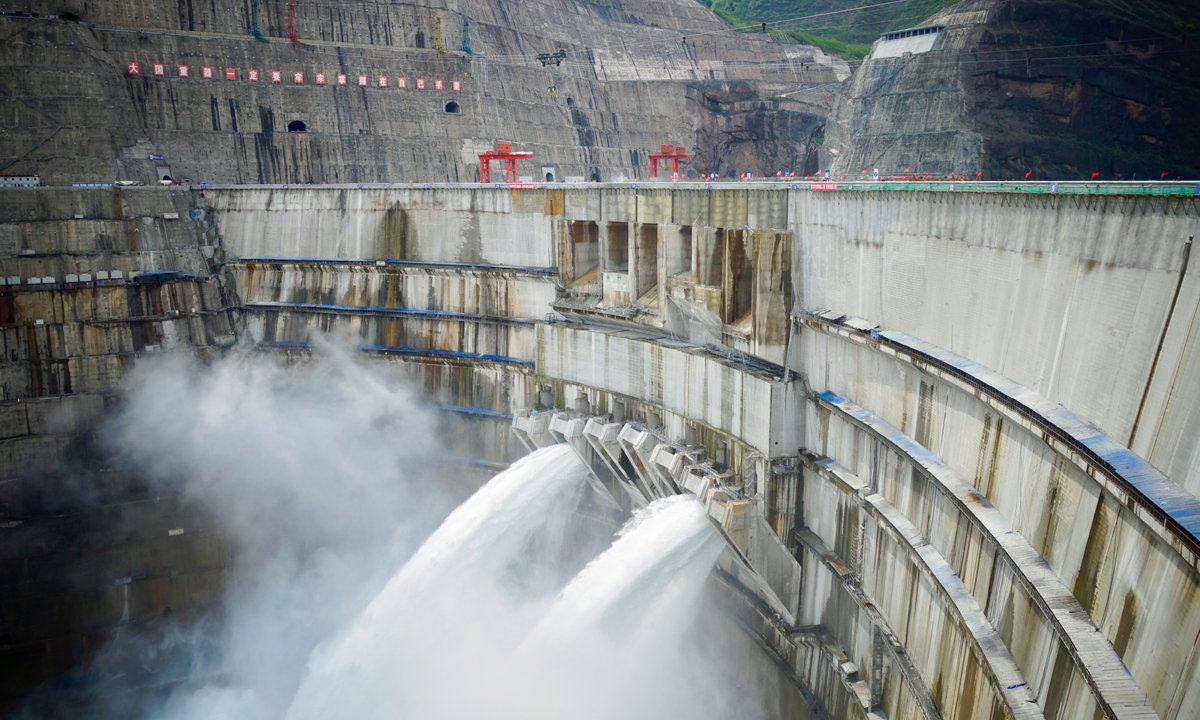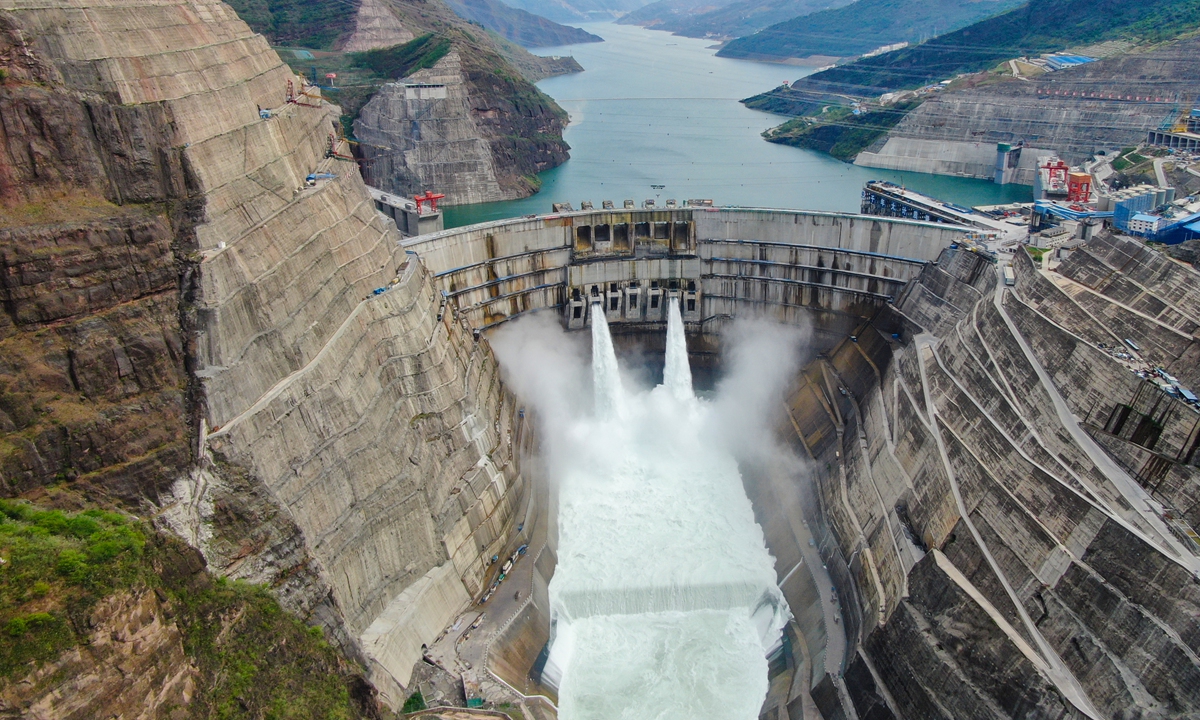
No. 1 generating unit at Baihetan Hydropower Station starts operations. Photo: Lin Xiaoyi/GT
Three days ahead of the 100th anniversary of the founding of the Communist Party of China (CPC), China presents yet another super project with a major breakthrough of Southwest China's Baihetan Hydropower Station added to the national celebration of the CPC's centenary, demonstrating to the world the advantages of socialism with Chinese characteristics.
Southwest China's Baihetan Hydropower Station, the world's largest hydropower project under construction, reached a milestone on Monday with the official start of operations for the first group of unique 1 million kilowatt-generating units.
At the site of the ceremony on Monday morning, engineers, construction workers and all other people who have made efforts toward the construction of the Baihetan Hydropower Station were waving the national flag in anticipation. When the lights for the operation of the generating units came on, applause and cheers rang out in the auditorium.
Chinese President Xi Jinping on Monday sent a letter to the Baihetan Hydropower Station, offering his congratulations on the launch of operations for its first two generating units.
As a major project in China's west-east power transmission program, the hydropower station is the largest and most technically difficult hydropower project under construction currently around the world, said Xi, also general secretary of the Communist Party of China Central Committee and chairman of the Central Military Commission.
Xi expressed hope that all the builders and relevant parties advance the station's follow-up work, make greater contributions to achieving the country's carbon-peak and carbon-neutralization goals, and promote the comprehensive green transformation of economic and social development.
Experts and officials noted that the commissioning of the first two generating units of the Baihetan Hydropower Station is a microcosm of the historic achievements of China's hydropower development under the leadership of the CPC, and is a testament to the high profile of "Made in China" and "Created in China," which continue to rise to the challenges and create history.
The Baihetan Hydropower Station is located downstream on the Jinsha River, an upper stretch of the Yangtze River, on the border of Southwest China's Sichuan and Yunnan provinces.

A view of the Baihetan Hydropower Station Photo: Lin Xiaoyi/GT
"It is a world-class project. Currently, there is no better station around the world," Chen Jianlin, Chief Engineer of the Baihetan Hydropower Station, told the Global Times on Monday, noting that since the start of construction of the Baihetan Dam in 2017, the project had to overcome extremely difficult technical problems, such as the fragile geology, the hot and dry winds in the valley, and the large excavation work.
The dam broke a number of world records, including the largest underground caverns, the largest anti-seismic parameters of a 300-meter high dam, and the largest spillway caverns.
Among the world records achieved by the Baihetan Hydropower Station, the one that stands out the most is the 1 million kilowatt Chinese-developed generator, with each unit being more than 50 meters high and weighing more than 8,000 tons, equivalent to the weight of the Eiffel Tower.
According to the calculations by engineers, a one million kilowatt generating unit can supply electricity in one hour to an ordinary Chinese family for more than 400 years.
The Baihetan Hydropower Station is equipped with 16 generating units, with an expected output of 62 billion kilowatt-hours of electricity per year, or more than 15 times the energy produced by the Hoover Dam in the US. It can help reduce China's carbon emissions by more than 51 million tons per year. The station is expected to be China's second largest hydropower project after the Three Gorges project once it is completed.
At the same time, the Baihetan Dam is the world's first "seamless dam." Construction of the 289-meter-high dam involved more than 8 million cubic meters of concrete. The material was specially designed by Chinese experts to prevent possible thermal cracks which can occur due to changes in temperature.

The Baihetan Dam opens to release water. Photo: Lin Xiaoyi/GT
"Over a hundred years ago, the construction of China's first hydropower station, the Shilongba Hydropower Station, also located in Yunnan Province, was once forced to stop when foreign engineers left, because at that time, China was poor and weak. After the New China was founded, Chinese engineers continued to close the gap with foreign advanced technologies. Now, even if we are technologically besieged by some countries, China still leads the hydropower development in the world," He Wei, Deputy Director of the Baihetan Hydropower Station Engineering and Construction Department, told the Global Times on Monday.
After 70 years of planning and more than 10 years of construction, the Baihetan project, supported by China's strong national power and leadership from the CPC, has conquered a series of technical difficulties and challenges, including the COVID-19 pandemic, to become a reality, said Lei Mingshan, Chairman of the China Three Gorges Corp, investor and main builder of the Baihetan Hydropower Station.

The first batch of million-kilowatt generating units, with the largest single-unit capacity in the world begins operation on Monday at Baihetan Hydropower Station, the world's largest hydropower project under construction. Photo: IC
Lei pointed out that the important landmark, part of the celebration of the 100th anniversary of the CPC, and an accurate realization of the goal of hydropower generation fully reflects China's strong organizational and mobilizational capabilities, and fully proves the institutional advantages of socialism with Chinese characteristics.
The station will be in full operation by the end of 2022. The rest of the 14 generators are planned to start operations by July 2022.
Major infrastructure achievements have been debuted one by one in recent days to mark the journey of the Chinese construction miracles under the leadership of the CPC.
Also on Monday, the Tiaoshun Bridge in Zhanjiang, South China's Guangdong Province, was inaugurated to link the western part of Guangdong with the Guangdong-Hong Kong-Macao Greater Bay Area.
On Friday, people in Southwest China's Tibet Autonomous Region danced and sang to welcome its first electrified railway ever built in the high plateau region. The new railway linking regional capital Lhasa with the city of Nyingchi officially began operations in Tibet.
More achievements in military, aerospace, likely for CPC's centenaryDuring the passing weekend, the People's Liberation Army (PLA) Navy opened its new museum in Qingdao, East China's Shandong Province, showcasing the historical achievements the PLA Navy has made under the leadership of the CPC.
The First Aircraft Research and Design Institute under state-owned Aviation Industry Corporation of China (AVIC), the developer of Chinese warplanes including the Y-20 strategic transport aircraft and the JH-7 fighter bomber, announced in a statement on Friday that a key project reached a major objective on Thursday, five months earlier than the original schedule, being a great gift for the CPC's centenary. The statement did not reveal the nature of the project nor the nature of the major objective, but said it was very challenging and was not previously even expected to be accomplished on schedule.
Another AVIC branch, the Chengdu Aircraft Research and Design Institute, developer of the J-20 stealth fighter jet, revealed in a statement released on its official WeChat account last week that it was developing an undisclosed new aircraft, and an undisclosed aircraft was about to make its first flight. It did not elaborate if the two undisclosed aircraft were the same aircraft.
Military observers are also eagerly waiting to see if China will announce any more achievements in major military programs.
Foreign reports, like one from the US-based Center for Strategic & International Studies, have been closely tracking the development progress of China's third aircraft carrier over the past month. While it will not likely be launched anytime soon despite its reported smooth construction, military enthusiasts are waiting to see if there will be any official announcement, as the PLA has yet to officially reveal its existence.
It is also possible that some of the new warships could enter PLA naval service around the date, observers predicted.
In the aerospace domain, it is also highly anticipated that the Shenzhou-12 crew of three taikonauts who are stationed in the country's Tianhe space station core module would send their blessings to mark the special day of celebration.
The crew who are all Party members have decorated the main compartment of the orbiting spacecraft with both the Chinese national flag and the CPC flag, as seen during their call with President Xi Jinping on June 23.
Following that, Sun Jun, the mission chief of the space station project at the Beijing Aerospace Flight Control Center, said on the same day that the first extravehicular activity or spacewalk of the taikonauts was expected to take place in some 10 days.
Observers and insiders reached by the Global Times also said that the three might put on their space suits for spacewalk missions as a congratulatory message and announced their readiness for the upcoming feat, which could fall on the weekend right after the Party anniversary, based on the mission planners' previous briefing.
The China National Space Administration on Sunday also released new visuals and sounds of the country's Zhurong Mars rover.
"The orbiter and the Mars rover are in good working condition, reporting safely from Mars to the Party and the motherland, and sending distant blessings on the century of the party's founding," a CNSA press statement said.

Highlights of world's second largest hydropower station Baihetan








